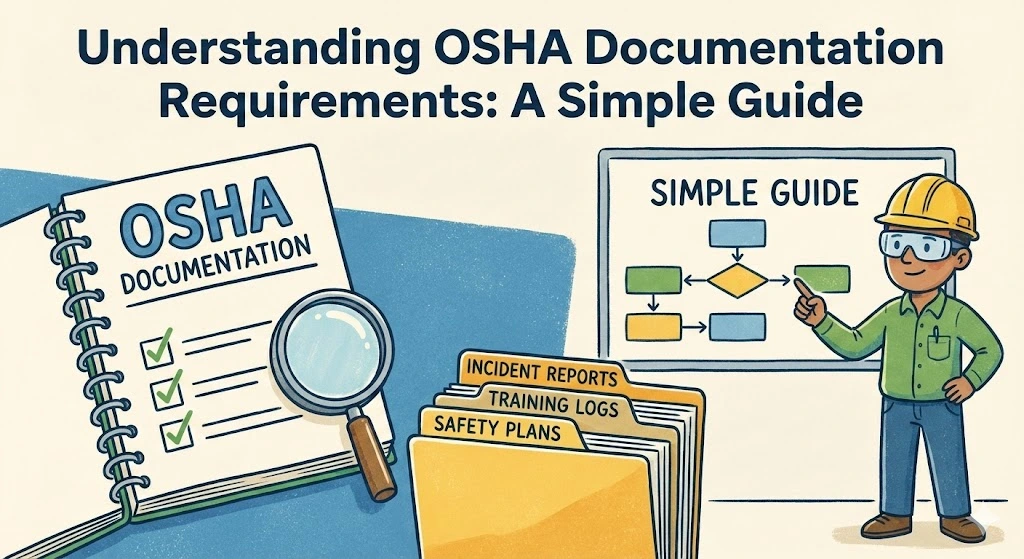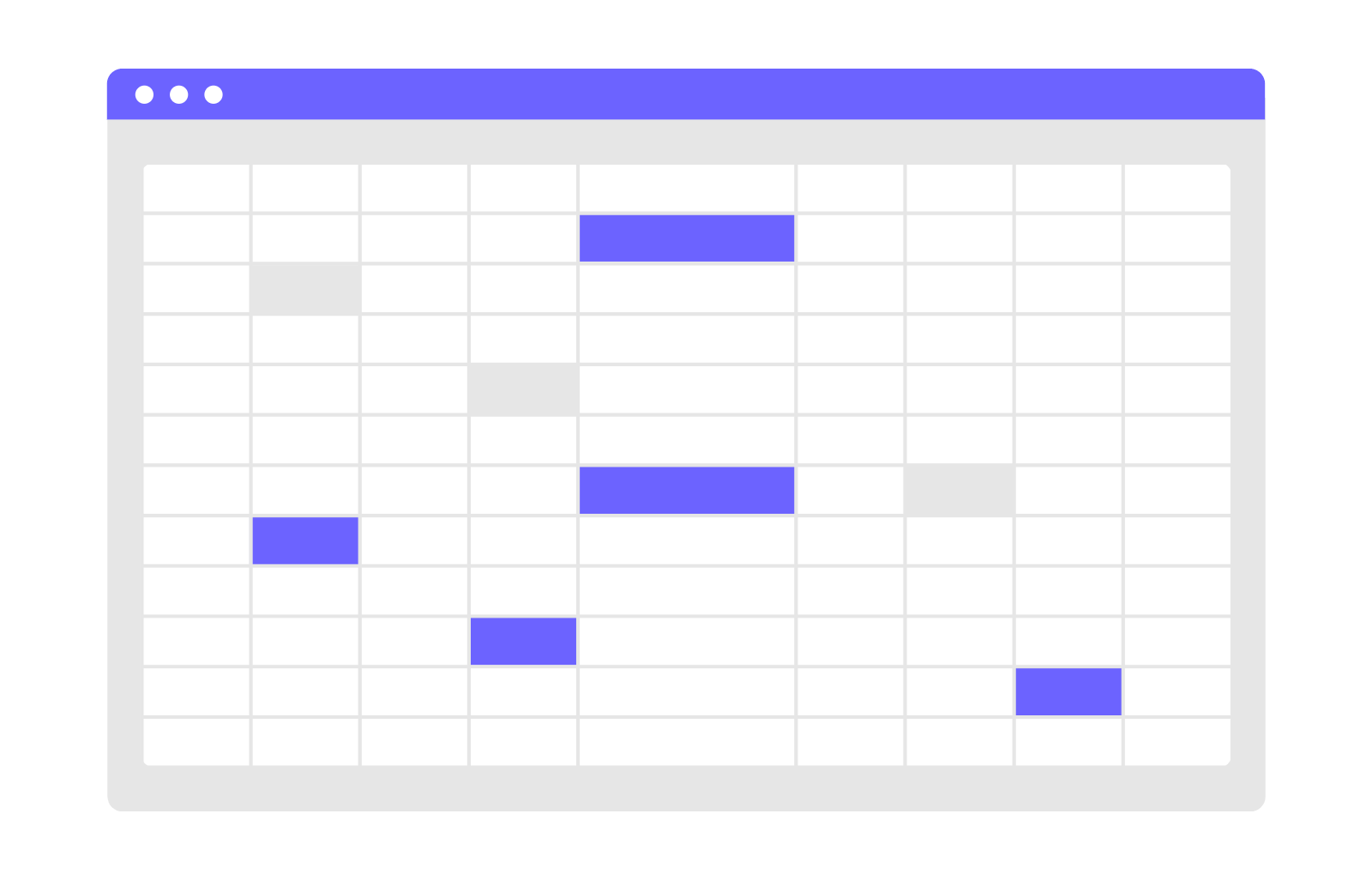Understanding OSHA Documentation Requirements: A Simple Guide
Master OSHA documentation requirements with this practical guide for business owners and managers. Learn which records you must keep, how long to retain them, and simple systems to stay compliant and avoid costly penalties.

Aaron Kushner is an entrepreneur with decades of hands-on experience running service companies and eCommerce operations. He founded DocuStrong to solve the compliance and document-tracking challenges he faced firsthand in the field.

OSHA penalties for documentation failures can reach hundreds of thousands of dollars. Even when safety protocols are in place and training has been conducted, without proper records to prove it, businesses face significant citations during inspections.

If you manage a business with employees, OSHA documentation isn’t optional-it’s a legal requirement that protects both your workers and your company. Yet many business owners find themselves confused about which documents they need to keep, how long to retain them, and how to organize everything for quick access during an inspection.
For more insights on compliance and regulations, explore our comprehensive resource library covering everything from document management best practices to industry-specific compliance requirements.
This guide will walk you through exactly what OSHA requires, why it matters, and how to build a documentation system that keeps you compliant without overwhelming your team.
Key Takeaways
-
Four Core Document Categories: OSHA 300 injury/illness logs, training records, exposure monitoring results, and written safety programs
-
5-Year Rule: OSHA 300 logs and most incident records must be kept for 5 years
-
30-Year Rule: Medical surveillance and exposure monitoring records must be retained for 30 years
-
10-Employee Exemption: Only applies to OSHA 300 recordkeeping if you had 10 or fewer employees company-wide during the previous calendar year
-
Electronic Submission: Establishments with 100+ employees in high-hazard industries or 250+ employees must electronically submit Form 300A annually by March 2nd
Ready to simplify your OSHA compliance? Start your free DocuStrong trial and get your documentation system running in under an hour.
What Are OSHA Documentation Requirements?
OSHA documentation requirements are federally mandated employer records required under the Occupational Safety and Health Act and associated OSHA standards. These requirements exist to ensure employers are actively protecting workers from occupational hazards and can prove their safety efforts if questioned.
The Occupational Safety and Health Administration (OSHA) requires businesses to maintain several categories of documentation, including injury and illness records, safety training logs, exposure monitoring results, and equipment inspection reports. According to the OSHA Recordkeeping and Reporting Requirements, most employers with more than 10 employees at any time during the previous calendar year must keep these records for specific retention periods, typically ranging from one to thirty years depending on the document type. This count includes all employees company-wide, not just at individual locations. Important: The 10-employee exemption applies only to OSHA 300 recordkeeping, not to training, hazard communication, or written-program requirements.

Which OSHA Records Does Your Business Need to Keep?
The specific OSHA documentation your business requires depends on your industry, size, and workplace hazards, but most employers must maintain injury/illness logs, training records, and safety inspection reports. Understanding which documents apply to your operation is the first step toward building an effective compliance system.
What OSHA forms do I need? At minimum, most businesses with more than 10 employees need OSHA 300, 300A, and 301 forms for injury/illness recordkeeping, plus training records, Safety Data Sheets, and written safety programs applicable to their workplace hazards.
OSHA 300 Forms: Injury and Illness Records
The OSHA 300 series forms are the foundation of workplace safety recordkeeping. If you have more than 10 employees and aren’t in a specifically exempted low-hazard industry, you must maintain OSHA Form 300 (the log of injuries and illnesses), Form 300A (the annual summary that must be posted February 1 to April 30), and Form 301 (detailed incident reports for each recordable event).
What counts as recordable? According to OSHA’s recordkeeping guidelines, an injury or illness is recordable if it results in death, days away from work, restricted work, job transfer, medical treatment beyond first aid, loss of consciousness, or diagnosis of a significant injury by a healthcare professional.
These forms must be retained for five years. Even with zero incidents, you must maintain blank forms to demonstrate recordkeeping compliance.
Electronic Submission Requirement: Certain establishments must electronically submit their OSHA Form 300A annually through OSHA’s Injury Tracking Application (ITA) by March 2nd. This requirement applies to:
-
Establishments with 250 or more employees (in any industry)
-
Establishments with 100-249 employees in designated high-hazard industries (NAICS codes specified by OSHA)
Visit OSHA’s Injury Tracking Application to submit your data or verify if your establishment is covered.

Training and Education Records
Safety training documentation proves that employees received proper instruction before performing hazardous tasks. For each training session, you should maintain records that include:
-
The employee’s name and job title
-
The trainer’s name and qualifications
-
The date and duration of training
-
The topics covered and competency demonstrated
-
The employee’s signature acknowledging completion
Common training programs requiring documentation include Hazard Communication (HAZCOM) training on chemical safety, Personal Protective Equipment (PPE) usage, Lockout/Tagout (LOTO) procedures for equipment servicing, forklift and powered industrial truck operation, confined space entry procedures, emergency action and evacuation plans, and bloodborne pathogen exposure training for healthcare and related industries.
Retention period: Training record retention varies by OSHA standard. While maintaining records for the duration of employment plus one year is best practice, specific standards have different requirements. For example, forklift training (29 CFR 1910.178) requires documenting operator evaluations every three years, while respiratory protection (29 CFR 1910.134) requires fit testing documentation until the next test. Some standards like asbestos training under 29 CFR 1926.1101 require 30-year retention. Always consult the specific OSHA standard applicable to your training.
Exposure Monitoring and Medical Surveillance
If your workplace involves exposure to hazardous substances (chemicals, noise, silica, lead, asbestos, etc.), you must maintain air monitoring results showing employee exposure levels, noise dosimetry readings if workers are exposed to high noise levels (85 decibels or above), medical surveillance records including baseline and periodic health examinations, and respirator fit test records for employees required to wear respiratory protection.
The OSHA Access to Employee Exposure and Medical Records standard (29 CFR 1910.1020) requires maintaining exposure monitoring records for 30 years and medical records for the duration of employment plus 30 years.
Equipment Inspection and Maintenance Records
Regular equipment inspections aren’t just good practice-they’re often required by specific OSHA standards. Key documentation includes forklift and powered industrial truck pre-shift inspection logs, crane inspection records (daily, periodic, and annual), fall protection equipment inspection logs, fire extinguisher monthly checks and annual maintenance, and emergency eyewash station weekly activation tests.
Get started with DocuStrong today and build bulletproof compliance documentation.

Safety Data Sheets (SDS) and Chemical Inventory
Under the Hazard Communication Standard (29 CFR 1910.1200), employers must maintain a current Safety Data Sheet for every hazardous chemical in the workplace. Your SDS collection should be:
-
Complete - One SDS for each chemical product, even if you only use it occasionally
-
Current - SDS must be kept current based on the latest manufacturer updates when new hazard information becomes available
-
Accessible - Available to all employees during their work shifts
-
Organized - Easy to locate quickly in an emergency
Many businesses maintain both digital and physical SDS binders to ensure accessibility during power outages or emergencies. DocuStrong’s document management system allows you to digitally store SDS files with automated expiration tracking, so you’re notified when manufacturers release updated versions.
Required Written Safety Programs
What written programs does OSHA require? OSHA mandates written safety programs for specific workplace hazards. These programs must be documented, accessible, and reviewed annually:
-
Hazard Communication (29 CFR 1910.1200) - Chemical inventory, SDS management, labeling
-
Lockout/Tagout (29 CFR 1910.147) - Energy control procedures for equipment servicing
-
Respiratory Protection (29 CFR 1910.134) - Medical evaluations, fit testing schedules
-
Emergency Action Plan (29 CFR 1910.38) - Evacuation procedures, emergency contacts
-
Bloodborne Pathogens (29 CFR 1910.1030) - Exposure control for healthcare industries
Each program should be site-specific, reflecting your actual workplace conditions.
PPE Hazard Assessments and LOTO Procedures
Do I need to document hazard assessments? Yes. Under 29 CFR 1910.132(d), employers must perform and document workplace hazard assessments to determine necessary personal protective equipment. This written certification must include the workplace areas evaluated, the person conducting the assessment, the date, and the document identifying hazards and PPE selected.
The Lockout/Tagout standard (29 CFR 1910.147) requires documented energy control procedures for each piece of equipment requiring servicing. Operations managers and safety coordinators should maintain these assessments in an easily accessible format and update them when workplace conditions change.
How Long Must You Keep OSHA Documentation?
OSHA retention requirements vary by document type, ranging from one year for some inspection records to 30 years for medical and exposure monitoring records. Missing these retention deadlines can result in citations and penalties, even if your current safety practices are excellent.
How long must OSHA medical records be kept? Medical surveillance and exposure monitoring records must be retained for the duration of employment plus 30 years after termination, as required by OSHA standard 29 CFR 1910.1020.
Here’s a practical retention schedule for the most common OSHA documents:
OSHA Documentation Retention Schedule
| Document Type | Retention Period | CFR Reference | Notes |
|---|---|---|---|
| OSHA 300/300A/301 Forms | 5 years | 29 CFR 1904.33 | Must keep for 5 years following the year covered |
| Safety Training Records | Varies by standard | Various | Consult specific standard; employment + 1 year is best practice |
| Exposure Monitoring | 30 years | 29 CFR 1910.1020 | Access to Employee Exposure and Medical Records |
| Medical Surveillance Records | Employment + 30 years | 29 CFR 1910.1020 | Must be maintained by employer or physician |
| Equipment Inspection Logs | 1-3 years minimum | Equipment-specific | Longer retention recommended for liability protection |
| Safety Data Sheets | 30 years | 29 CFR 1910.1020 | Maintain chemical identity/exposure information |
| Incident Investigation Reports | 5+ years recommended | Not required | Crucial for liability defense and continuous improvement |
| Safety Committee Meeting Minutes | 3-5 years recommended | Not required | Demonstrates ongoing safety commitment |
Why such long retention periods? Occupational illnesses like hearing loss or lung disease can take decades to develop. Long retention periods ensure workers can access their exposure history if health issues arise years after employment.

Building an OSHA-Compliant Documentation System
An effective OSHA documentation system is organized, accessible, regularly updated, and includes clear processes for creating, reviewing, and retaining records. You don’t need complex software-you need a consistent approach that your entire team understands and follows.
Ready to eliminate compliance gaps? Start your free trial and get complete visibility into your compliance status.
Step 1: Conduct a Documentation Audit
Inventory existing records, identify gaps by comparing against OSHA requirements, review retention compliance, and assess whether you can locate any document within 2-3 minutes during an inspection.
Step 2: Establish Documentation Responsibilities
Assign clear ownership: safety coordinator for OSHA 300 logs, supervisors for daily inspections, HR for training records, maintenance staff for equipment logs. Document responsibilities in writing.
Step 3: Create Standard Templates
Develop standardized templates for inspections, training, incident investigations, and hazard assessments with all required information fields.
Step 4: Implement a Document Management System
Manual paper-based systems can work for very small operations, but digital solutions offer significant advantages: centralized storage with searchable access, automated expiration reminders, version control tracking historical records, access control for sensitive medical information, and audit trails documenting who accessed or modified records.
DocuStrong’s expiration tracking feature automatically monitors all your OSHA documents and sends reminders before certifications expire or training renewals come due-helping you stay ahead of compliance deadlines.

Common OSHA Documentation Mistakes (And How to Avoid Them)
Even well-intentioned employers make documentation errors that can lead to citations during inspections. Here are the most frequent mistakes and practical solutions:
Mistake #1: Treating First Aid as “Recordable”
The problem: Many employers record every minor injury on their OSHA 300 log, including true first aid incidents.
Why it matters: Over-recording inflates your injury rate and may raise questions during OSHA’s site-specific targeting process.
The solution: OSHA distinguishes between “first aid” and “medical treatment beyond first aid.” Use this quick reference:
✓ Recordable (Medical Treatment Beyond First Aid):
-
Stitches or sutures
-
Prescription medications
-
Physical therapy
-
Chipped or broken teeth
-
Puncture wounds from dirty objects requiring more than tetanus shot
-
Second or third-degree burns
✗ Not Recordable (First Aid Only):
-
Tetanus shots, boosters, or immunizations
-
Wound coverings like bandages, butterfly bandages, Steri-Strips
-
Hot or cold therapy
-
Non-prescription medications at non-prescription strength
-
First-degree burns
-
Finger guards or massaging
Maintain a separate first aid log to track minor injuries for prevention analysis without incorrectly classifying them as recordable.
Mistake #2: Incomplete Training Documentation
The problem: Training records that simply list “John attended forklift training on 5/15/24” without details on what was covered, who conducted the training, or how competency was verified.
Why it matters: During an inspection, OSHA expects to see evidence that training was comprehensive and effective-not just that employees were in a room for a certain time period.
The solution: Every training record should document who was trained (name, job title), what topics were covered, when training occurred (date and duration), who conducted it (name and qualifications), how competency was demonstrated (test scores, practical demonstration), and include the employee’s acknowledgment signature.
Consider implementing practical evaluations where employees must demonstrate their knowledge. A forklift operator should complete a supervised operation, not just watch a video.
Mistake #3: Losing Track of Document Expiration Dates
The problem: Certifications, training records, medical surveillance, and equipment inspections all have expiration dates. Missing these deadlines creates compliance gaps.
Why it matters: An expired forklift certification or overdue respiratory fit test means employees aren’t authorized to perform those tasks-creating immediate OSHA violations if discovered during an inspection.
Start Your Free Trial - No credit card required. Get your compliance system up and running in under an hour.
The solution: Create a master calendar tracking all expiration dates including employee training renewals, equipment certifications and inspections, medical surveillance examinations, and permit renewals.
DocuStrong’s platform provides automatic status monitoring with customizable advance warnings (7-90 days) before documents expire, allowing you to schedule renewals proactively rather than discovering expired records during an audit.

What Happens During an OSHA Inspection?
OSHA inspections typically involve a document review, workplace walkaround, and employee interviews-and your documentation will be scrutinized throughout the process. Understanding what inspectors look for helps you prepare effectively.
The Three Phases of an OSHA Inspection
Phase 1: Opening Conference
The compliance officer explains the inspection reason and requests OSHA 300 logs for the past five years, written safety programs (e.g., Hazard Communication per 1910.1200, Lockout/Tagout per 1910.147), training records, and inspection/test records. Quick document access creates a positive impression.
Phase 2: Workplace Walkaround
The inspector tours your facility looking for hazards and may request equipment inspection logs, Safety Data Sheets, confined space permits, and PPE certifications.
Phase 3: Closing Conference
The inspector discusses findings and any violations. This is your opportunity to provide additional documentation addressing concerns.
Documents OSHA Will Review
Be prepared to provide OSHA 300 logs, training records for equipment operators, written safety programs, equipment inspection records, hazard assessments, and Safety Data Sheets. Quick document retrieval demonstrates a well-managed program.

Frequently Asked Questions About OSHA Documentation
What are OSHA recordkeeping requirements for small businesses?
Not exactly the same as large companies. Businesses with 10 or fewer employees at any time during the previous calendar year are generally exempt from OSHA 300 recordkeeping requirements unless specifically requested. However, small businesses still must maintain training records, Safety Data Sheets, written safety programs required by specific standards, and equipment inspection logs. The OSHA Small Business page provides resources for smaller operations.
What if I discover I didn’t record an injury on my OSHA 300 log?
If you determine that an injury or illness should have been recorded but wasn’t, you must add it to your OSHA 300 log as soon as you discover the error-even if it’s in a past year. OSHA allows corrections for up to five years. The key is making the correction promptly. Intentionally failing to record a known incident is a serious violation, but honest mistakes that are corrected show good faith compliance efforts.
Can I keep OSHA records electronically?
Yes. OSHA explicitly permits electronic recordkeeping as long as records are readily accessible, can be produced in readable format when requested, and are maintained for the required retention period. Many businesses find digital systems more efficient because they’re searchable, can be backed up, and don’t require physical storage space. Ensure your electronic system is secure and you can quickly produce records during an inspection.
How do I handle OSHA documentation when an employee leaves?
When an employee terminates, you must retain their training records for at least one year after departure and their exposure/medical records for 30 years after termination (if applicable). You don’t need to provide departing employees with copies unless they specifically request them. If an employee requests their records after departure, the same 15-day access rule applies.
OSHA Documentation Quick Reference Guide
Common OSHA Standards Referenced
For quick reference, the most frequently applicable OSHA standards for documentation:
-
29 CFR 1904 - Recording and Reporting Occupational Injuries and Illnesses
-
29 CFR 1910.1020 - Access to Employee Exposure and Medical Records
-
29 CFR 1910.134 - Respiratory Protection
-
29 CFR 1910.147 - Lockout/Tagout
-
29 CFR 1910.1200 - Hazard Communication
-
29 CFR 1910.132(d) - PPE Hazard Assessment
Key Terms: OSHA Documentation Glossary
Recordable Incident - A work-related injury or illness resulting in death, days away from work, restricted work, medical treatment beyond first aid, loss of consciousness, or significant injury diagnosed by a healthcare professional.
SDS (Safety Data Sheet) - Detailed information sheet about hazardous chemicals, including physical properties, health hazards, protective measures, and emergency procedures.
Medical Surveillance - Periodic medical examinations required for employees exposed to specific workplace hazards such as noise, lead, or bloodborne pathogens.
Exposure Monitoring - Measurement of employee exposure to workplace hazards to determine if levels exceed permissible limits.
Taking Action: Your Next Steps for OSHA Compliance
OSHA documentation doesn’t have to be overwhelming. With the right system and approach, you can maintain complete compliance while focusing on what matters most-keeping your employees safe and your business running smoothly.
Transform your compliance approach from reactive to proactive. Join thousands of businesses using DocuStrong to maintain continuous compliance confidence.
Start with these immediate actions: Audit your current documentation to identify which required records you already maintain and which need improvement. Assign clear responsibilities ensuring every type of record has a designated owner. Create a centralized system for all OSHA documents. Set up expiration tracking so certifications and training don’t lapse. Schedule regular reviews to make documentation maintenance routine.
Remember that documentation serves a purpose beyond avoiding penalties. Every training record represents an employee better equipped to work safely. Every equipment inspection log represents potential hazards identified before they cause harm.
Ready to simplify your OSHA compliance?
DocuStrong provides a complete compliance tracking and document management platform designed specifically for busy operations managers and safety coordinators who need to maintain OSHA records without the administrative burden. With automated expiration tracking, customizable reminders, secure document storage, and real-time compliance scoring, you’ll always know exactly where you stand-and what needs attention.
Start your free trial today and discover how much easier OSHA documentation can be. Organized, automated, OSHA-ready-without the administrative hassle.

Technical Note for Web Publishing: To maximize search visibility, consider implementing structured data markup for this article:
-
FAQPage schema for the FAQ section
-
Article schema with author, datePublished, and dateModified properties
-
BreadcrumbList schema for site navigation
For a comprehensive overview of document management and compliance, see our complete guide: Document Management and Compliance: The Complete Guide. Want more practical compliance guidance? Explore our complete library of compliance and regulations resources covering everything from environmental permits to industry-specific safety requirements. Visit our homepage to learn more about how DocuStrong transforms compliance management for businesses of all sizes.
Related Articles

The Ultimate Compliance Checklist for Small Business Owners
A comprehensive guide to building and maintaining your business compliance program. Learn what documents you need, when to renew them, and how to avoid costly penalties with proven strategies from industry experts.

What Happens When Your Business License Expires? (And How to Avoid It)
An expired business license can halt operations, trigger fines up to $10,000, and damage your reputation. Learn what happens when licenses expire, how to prevent it, and why automated tracking is essential for compliance.

7 Compliance Mistakes That Cost Businesses Thousands (and How to Avoid Them)
Discover the most frequent compliance errors that lead to fines, operational disruptions, and reputational damage-plus practical strategies to prevent them before they impact your bottom line.
